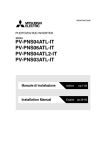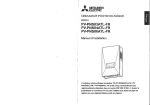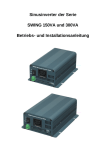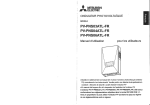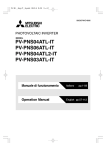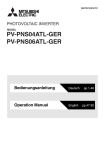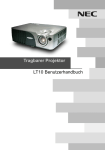Download 2 - Mitsubishi Electric
Transcript
0607874HC4901 PHOTOVOLTAIC INVERTER MODEL PV-PNS04ATL-GER PV-PNS06ATL-GER Installationshandbuch Deutsch pp.1-28 Installation Manual English pp.29-56 ,AKJI?D SOLARSTROM-WECHSELRICHTER MODEL PV-PNS04ATL-GER PV-PNS06ATL-GER Installationshandbuch pp.1-48 pp.1-48 Der Solar-Wechselrichter (PV-Inverter) PV-PNS04ATL-GER / PVPNS06ATL-GER entspricht den Anforderungen der DIN VDEpp.1-48 0126-1-1. Daher der dieser Wechselrichter nur in Ländern verwendet werden, in denen diese Richtlinie gilt. Inhaltsverzeichnis Seite 1 Einführung • • • • • • • 2 Sicherheitshinweise • • • • • • • • • • • • • • • • • • • • • • • • • • • • • • • • • • • • • • • • 3 Erscheinungsbild • • • • • • • • • • • • • • • • • • • • • • 3.1 Abmessungen • • • • • • • • • • • • • • • • • • • • 3.2 Interner Aufbau • • • • • • • • • • • • • • • • • • • 4 Zubehör und Teile • • • • • • • • • • • • • • • • • • • • • 5 Erforderliche Teile, Ausrüstung und Werkzeuge 6 Anforderungen 3 4 •5 •5 •5 •6 •7 • • • • • • • • • • • • • • • • • • • • • • • • • • • • • • • • • • • • • • • • • • • • • • • • • • • • • • • • • • • • • • • • • • • • • • • • • • • • • • • • • • • • • • • • • • • • • • • • • • • • • • • • • • • • • • • • • • • • • • • • • • • • • • • • • • • • • • • • • • • • • • • • • • • • • • • • • • • • • • • • • • • • • • • • • • • • • • • 8∼11 6.1 Installationsort • • • • • • • • • • • • • • • • • • • • • • • • • • • • • • • • • • • • 8∼10 6.2 Anschluss an Solarzellen • • • • • • • • • • • • • • • • • • • • • • • • • • • • • • • 11 6.3 Anschluss an ein Netz • • • • • • • • • • • • • • • • • • • • • • • • • • • • • • • • • 11 • • • • • • • • • • • • • • • • 12∼13 • • • • • • • • • • • • • • • • • • • • • • • • • • • • • • • • • • • • • • 14∼20 7 Installation des Solarstrom-Wechselrichters • • (PV-PNS04ATL-GER / PV-PNS06ATL-GER) 8 Anschlusskabel 8.1 Solarzellenanschluss (DC-Eingang) 8.2 Anschluss AC-Ausgang • • • • • • 8.3 Nach dem Anschluss der Kabel • • • • • • • • • • • • • • • • • • • • • • • • • • • • • • • • • • • • • • • • • • • • • • • • • • • • • • • • • • • • • • • • • 14∼17 18∼19 • • • • 20 9 Probelauf • • • • • • • • • • • • • • • • • • • • • • • • • • • • • • • • • • • • • • • • • • • 21∼24 9.1 Tests vor Inbetriebnahme • • • • • • • • • • • • • • • • • • • • • • • • • • • • • • • 21 9.2 Probelauf starten • • • • • • • • • • • • • • • • • • • • • • • • • • • • • • • • • 9.3 Problembeseitigung • • • • • • • • • • • • • • • • • • • • • • • • • • • • • • • 10 Vorsichtsmaßnahmen bei der Wartung • • • • • • • • • • • • • • • • • • • • • 21∼22 23∼24 25∼26 11 Anhang • • • • • • • • • • • • • • • • • • • • • • • • • • • • • • • • • • • • • • • • • • • • 27∼28 11.1 Schraubenauswahl • • • • • • • • • • • • • • • • • • • • • • • • • • • • • • • • • • • 27 11.2 Kabelauswahl • • • • • • • • • • • • • • • • • • • • • • • • • • • • • • • • • • • 27∼28 11.3 Kabelösen und Werkzeuge • • • • • • • • • • • • • • • • • • • • • • • • • • • • • 28 2 1 Einführung ,AKJI?D Der Solarstrom-Wechselrichter PV-PNS04ATL-GER / PV-PNS06ATL-GER wandelt Gleichstrom erzeugt durch Solarzellen in Wechselstrom um und speist diesen in ein Stromnetz ein. In diesem Installationshandbuch werden die Montage des Wechselrichters, der Anschluss an die Solarzellen und an das Stromnetz, sowie der Testlauf des Wechselrichters beschrieben. Die Bedienung des Solarstrom-Wechselrichters PV-PNS04ATL-GER / PVPNS06ATL-GER wird in dem entsprechenden Kapitel "SOLARSTROMWECHSELRICHTER PV-PNS04ATL-GER / PV-PNS06ATL-GER Bedienungsanleitung" beschrieben. Der PV-Inverter PV-PNS04ATL-GER / PV-PNS06ATL-GER entspricht den Vorschriften zur elektromagnetischen Verträglichkeit pp.1-48 und den Niederspannungs-Richtlinien. Außerdem werden die Vorschriften der DIN VDE 0126-1-1 abgedeckt. pp.1-48 pp.1-48 3 2 Sicherheitshinweise Der Wechselrichter darf nur von ausgebildeten Technikern installiert werden. Die Installationsarbeiten dürfen nur durchgeführt werden, wenn das Gerät auf der Gleich- und Wechselstromseite vom Netz getrennt wurde. ● Die folgenden Symbole zeigen den Grad und die Art der Gefährdung, wenn die Sicherheitshinweise nicht beachtet werden. /0!1! * 2 ) ' ( ) / ) ! ' ' ( ) " * + '( ) ,- ( $ ( . " % !" # $% & 4 3 Erscheinungsbild 3.1 Abmessungen ×φ 3.2 Interner Aufbau Die nachstehende Abbildung zeigt den internen Aufbau und die Anschlüsse bei abgenommener Frontplatte. ① ① ② ③ ④ ⑩ ⑪ ⑧ ! " ③ ④ ⑤ pp.1-48 ⑥ ⑧ ⑥ ⑨ ⑦ ⑩ ⑪ ⑨ 5 pp.1-48 ② ⑦ ⑤ pp.1-48 ,AKJI?D ■ 4 Zubehör und Teile Der PV-Inverter PV-PNS04ATL-GER / PV-PNS06ATL-GER wird mit dem folgenden Zubehör und den nachstehenden Teilen ausgeliefert. Prüfen Sie die Lieferung anhand der nachstehenden Liste auf Vollständigkeit. ① ② !" ③ φ ④ φ ⑤ ⑥ #" ⑧ ! ⑦ ! $ % $ 6mm Nr. ① ② ③ ④ ⑤ ⑥ ⑦ ⑧ & Teil Solarstrom-Wechselrichter Montageplatte Schutzrohr (φ20) Schutzrohr (φ10) Kabelbinder Bedienungsanleitung Installationshandbuch (dieses Dokument) Kabellehre 6 Anzahl 1 1 3 6 7 1 1 1 Ja 5 Erforderliche Teile, Ausrüstung und Werkzeuge Schaltplan (für ein Zwei-Stringsystem) ② ⑤ ① ⑥ Beizustellende Teile ① ② ③ ④ ⑤ ⑥ DC-Kabel AC-Kabel Kabelöse (φ5) für Klemmenleiste Kabelöse (φ4) für Massekabel DC-Trennschalter AC-Trennschalter Siehe Seite 27 Siehe Seite 28 Siehe Seite 28 Siehe Seite 28 ⑦ Befestigungsschrauben Wechselrichter Wählen Sie die Schrauben nach den für die Wand verwendeten Materialien. Details finden Sie auf Seite 27. Zubehör und Werkzeuge für Elektroarbeiten Zwickzange Zange Kreuzschlitzschraubenzieher Crimp-Werkzeug (nach Herstellerangaben) Ausgangs-Messinstrument Tester (für mehr als 700 V DC) Massetester * Bereiten Sie alle Teile vor. 7 pp.1-48 pp.1-48 pp.1-48 ,AKJI?D 6 Anforderungen Stellen Sie vor der Installation des Wechselrichters PV-PNS04ATL-GER / PVPNS06ATL-GER sicher, dass die folgenden Anforderungen erfüllt werden. 6.1 Installationsort Auswahl und Vorbereitung des Montageplatzes Achten Sie bei der Installation des Wechselrichters auf die folgenden Voraussetzungen, damit er optimal und sicher arbeitet. ● Installieren Sie den Wechselrichten in einem Gebäude. Der Wechselrichter darf NICHT im Außenbereich, wie auf einer Seite offene Garagen, montiert werden (Der Montageplatz muss durch Türen gesichert sein.. ● Montieren Sie den Wechselrichter waagerecht an einer Wand, die das Gewicht des Geräts tragen kann. Ist die Wand nicht stark genug, verstärken Sie die Wand vor der Installation. (PV-PNS04ATL-GER wiegt 19 kg; PVPNS06ATLGER 20 kg. (einschl. Montageplatte)) (Sie auf Seite 27.) ● Umgebungstemperatur: -25 - 60°C Relative Feuchte 30 - 90%. Montieren Sie den Wechselrichter im Gebäude an einer Stelle, an der keine Kondensatbildung durch Temperaturschwankungen auftreten kann. ● Vermeiden Sie direkte Sonneneinstrahlung. (Durch sehr hohe Temperaturen kann die Leistung sinken.) ● Montieren Sie den Wechselrichter an einem Ort der tiefer als 1.500 m unter Normal-Null liegt. ● Sorgen Sie um den Wechselrichter für ausreichenden Platz, damit die Kühlung optimal ist und er einfach gewartet werden kann (Bei einer Installation von mehreren Inverter finden Sie entsprechende Details auf Seite 10.) 8 ACHTUNG ・Außen oder Außenbereiche (* NICHT in Bereichen, wie auf einer Seite offene Garagen, montiert, der Montageplatz muss durch Türen gesichert sein. ・Stellen mit direkter Sonneneinstrahlung ・Enge Stellen mit schlechter Lüftung ・Stellen, an denen Wasser frei wird ・Stellen mit sehr hoher Luftfeuchtigkeit, wie Waschräume ・Stellen mit Dampf, Ölnebel, Rauch Staub, Salz oder korrosiven Substanzen ・Stellen mit Öldämpfen, wie Küchen ・Stellen mit explosiven oder brennbaren Gasen ・Stellen, an denen Vibrationen und Stöße auftreten ・Stellen in der Nähe von brennbaren Materialien ・Orten mit nicht normalen Betriebsbedingungen, die oben nicht beschrieben wurden (beispielsweise Schiffe oder Motorfahrzeuge) ・Stellen mit salzhaltiger Luft pp.1-48 Hinweis Installieren Sie den Wechselrichter nicht an den folgenden Stellen: pp.1-48 (Anderenfalls kann der Wechselrichter elektrische Störungen hervorrufen.) ・Stellen, an denen elektrische Störungen nicht auftreten dürfen ・Stellen in der Nähe von Fernseh- und Rundfunkgeräten oder Kabeln pp.1-48 9 ,AKJI?D Installieren Sie den Wechselrichter nicht unter folgenden Bedingungen: (Anderenfalls kann der Wechselrichter herunterfallen oder rein sicherer Betrieb ist nicht möglich. Außerdem kann die Garantie verfallen.) (Vorsichtsmaßnahmen bei der Installation von mehreren Wechselrichtern) ● Installieren Sie die Wechselrichter nebeneinander mit ausreichendem Abstand. ● Da sich eine größere Hitze entwickelt als bei der Installation von nur einem Wechselrichter müssen die Zwischenräume belüftet werden. Bei der Stromerzeugung gibt der Wechselrichter Wärme ab, die durch die Lüftungsöffnung (oder Absaugung) an der linken Seite austritt. Ist der Wechselrichter 'B' direkt rechts vom Wechselrichter 'A' installiert kann die von 'A' freiwerdende Wärme die Leistung von 'B' beeinträchtigen. Hei§e Luft A Hei§e Luft B ○ (Rechts) 0 oder mehr 200 oder mehr × (Falsch) Seitlicher Abstand zwischen den Wechselrichtern Senkrechter Abstand zwischen den Wechselrichtern Ma§einheit: mm 10 6.2 Anschluss an Solarzellen An den Wechselrichter können bis zu drei Strings angeschlossen werden. DC-Eingang Maximale Spannung (je String) Minimale Spannung (je String) Max. Strom (Summe aller Strings) 700 V DC 150 V DC 18 A DC ● Zur sicheren Arbeit bei Installation und Wartung muss zwischen dem Wechselrichter und den Solarzellen immer ein DC-Trennschalter angebracht sein. 6.3 Anschluss an ein Netz Bei dem Anschluss des Wechselrichters an das Netz müssen die entsprechenden örtlich geltenden Vorschriften und Regelungen beachtet pp.1-48 werden. ● Achten Sie darauf, dass das Netz, an den Sie den Wechselrichter anschließen, die folgenden Anforderungen erfüllt: Spannungsbereich Frequenzbereich Voraussetzungen 184−264 V 49,8−50,2 Hz pp.1-48 ● Es müssen Kabelquerschnitte, die der Kabellänge entsprechen, verwenpp.1-48 det werden, um den Leistungsverlust auf ein Minimum zu reduzieren. ● Zwischen dem Netz und de, Wechselrichter muss immer ein ACTrennschalter vorgesehen werden. 11 ,AKJI?D ● Achten Sie darauf, dass die Größe und Spezifikationen der Solarzellen, die Sie an den DC-Eingang anschließen, den Anforderungen des Wechselrichters entsprechen. (Aktive Module müssen den folgenden Gleichstromspezifikationen entsprechen.) 7 Installation des Solarstrom-Wechselrichters (PV-PNS04ATL-GER / PVPNS06ATL-GER) Im Folgenden wird die Installation des Wechselrichters beschrieben. <Montage der Montageplatte> ●Wählen Sie die Schrauben nach den für die Wand verwendeten Materialien. (Details finden Sie im "Anhang" auf Seite 27.) 1. Drehen Sie die Schrauben in die obere mittige Bohrung der Montageplatte, ziehen sie aber noch nicht fest. ● Die Schraube muss senkrecht zur Wand ausgerichtet sein. 1 2. Hängen Sie die Montageplatte auf die Schrauben. Justieren Sie die senkrechte Ausrichtung der Montageplatte. 1. Drehen Sie jetzt auch die restlichen sechs Schrauben in die jeweiligen Montagebohrungen. 2 3 2. Ziehen Sie jetzt die Schrauben fest an. Vergewissern Sie sich, dass die Montageplatte waagerecht ausgerichtet ist. 12 <Montage des Wechselrichters> 1. Entfernen Sie die beiden Schrauben unten am Wechselrichter. ,AKJI?D 1 SolarstromWechselrichter Schraube Falz (Aufhngung) SolarstromWechselrichter 1. Führen Sie die Falz im oberen Bereich der Rückseite des Nut Wechselrichters in die Nut der Montageplatte. Hierdurch wird der Wechselrichter von der Montageplatte gehalten. 2 2. Befestigen Sie den Wechselrichter pp.1-48 mit den in 1-1 entfernten Schrauben auf der Montageplatte. ● Drehmoment: 1,4-1,6 N・m Schraube 3 pp.1-48 Montageplatte Achten Sie darauf, dass der Wechselrichter nicht auf der Montageplatte wackelt. pp.1-48 13 8 Anschlusskabel 8.1 Solarzellenanschluss (DC-Eingang) Gehen Sie beim Anschluss des DC-Eingangs des Wechselrichters wie folgt vor. 1. Prüfen Sie die Polung und die maximale Spannung der Solarzellen-Strings. ● An den Solarzellen liegt eine gefährlich hohe Gleichspannung an. Befolgen Sie unbedingt die erforderlichen Sicherheitsvorkehrungen. 2. Prüfen Sie, ob die Trennschalter für AC und DV AUSGESCHALTET sind. ● Sorgen Sie dafür, dass während der Arbeiten AC- und DC-Trennschalter nicht wieder eingeschaltet werden können. Folgen Sie den nachstehenden Anweisungen, um die von den Solarzellen kommenden Kabel anzuschließen (DC-Eingang). 1 Schalten Sie den DC-Trennschalter AUS. ② Frontplatte ③ 2 ① Entfernen Sie die beiden Schrauben, mit denen die Frontplatte unten befestigt ist. ② Nehmen Sie die Frontplatte ab. ③ Lösen Sie auch das Massekabel von der Frontplatte. Massekabel ① ● Nehmen Sie das isolierte Teil des Massekabels und ziehen es in die abgebildete Richtung. Schraube Kabellehre 3 6mm DC-Kabel Prüfen Sie den Kabelquerschnitt des DCKabels mit Hilfe der Kabellehre. Schieben Sie das DC-Kabel durch die Öffnung in der Kabellehre. Hierdurch sehen Sie, ob der Kabelquerschnitt größer oder kleiner als 6 mm ist. (Anschlussmethoden für andere Kabelquerschnitte finden Sie auf Seite 16-6.) 14 4 DC DC ※Sollen mehrere Kabel hindurchgeführt werden, lösen Sie zunächst die Kabelverschraubung und entfernen dann die Schutzkappe. Litze 5 etwa 1 mm Pressen Sie auf die Markierung DC (+) - Kabel DC (+) – Kabel DC(+) Kabelverschraubung (schwarz) DC (-) - Kabel DC (-) – Kabelverschraubung (silbergrau) Versehen Sie die DC-Kabel mit Kabelösen (φ5 ), die dem Kabeldurchmesser entspricht. (Siehe "Anhang" Seite 27) DC (+) -Kabel pp.1-48 pp.1-48 pp.1-48 15 ,AKJI?D Führen Sie das Kabel der Solarzellen (DC-Eingang) vom DC-Trennschalter durch die DC-Kabelverschraubung (kleinerer Durchmesser) in den unteren Bereich des SolarstromWechselrichters. Für DC-Kabel > 6 mm 1. Entfernen Sie die Kabelklemme. 2. Ziehen Sie das DC-Kabel durch das Schutzrohr (φ10). 3. Befestigen Sie das Rohr mit dem DCKabel mit Hilfe eines Kabelbinders. 4. Schließen Sie das DC-Kabel an die Klemmenleiste an. ● Drehmoment: 2,6-3,4 N・m ● Achten Sie darauf, dass das DC + nicht mit dem DC – Kabel vertauscht wird. ● Vergewissern Sie sich, dass das Schutzrohr installiert ist. Dies ist erforderlich, damit das Kabel nicht beschädigt wird und Feuer sich nicht ausbreiten kann. 6 Für DC-Kabel ≦ 6mm 1. Entfernen Sie die Kabelklemme. 2. Ziehen Sie das DC-Kabel durch das Schutzrohr (φ20). 3. Schließen Sie das DC-Kabel an die Klemmenleiste an. ● Drehmoment: 1,4-1,6 N・m ● Achten Sie darauf, dass das DC + nicht mit dem DC – Kabel vertauscht wird. 4. Befestigen Sie die Kabelklemme wieder, so dass das Schutzrohr mit dem Kabel gehalten wird. ● Drehmoment: 2,6-3,4 N・m ● Vergewissern Sie sich, dass das Schutzrohr installiert ist. Dies ist erforderlich, damit das Kabel nicht beschädigt wird und Feuer sich nicht ausbreiten kann. 16 Befestigen Sie die DCKabelverschraubung ● Drehmoment: 3 N・m 7 Schalten Sie den DC-Trennschalter EIN und prüfen Sie die Spannung zwischen den Klemmen DC + und DC – auf der Klemmenleiste des DC-Eingangs. 8 pp.1-48 Achten Sie darauf, dass die Schutzkappen an den nicht verwendeten Kabelverschraubungen vorhanden sind. 9 Schalten Sie den DC-Trennschalter AUS. 10 pp.1-48 pp.1-48 17 ,AKJI?D ● Achten Sie darauf, dass auf das Kabel kein Zug ausgeübt wird. 8.2 Anschluss AC-Ausgang Gehen Sie beim Anschluss des Wechselrichters an den DC-Ausgang wie folgt vor. 1. Prüfen Sie das Netz auf korrekte Spannung. ● Überzeugen Sie sich, dass die Spannung zwischen 184 und 264 V liegt. 2. Prüfen Sie, ob die Trennschalter für AC und DV AUSGESCHALTET sind. ● Sorgen Sie dafür, dass während der Arbeiten der Stromfluss nicht wieder eingeschaltet werden kann. Gehen Sie beim Anschluss des AC-Kabels an den Wechselrichter wie folgt vor. ! "# 1 2 1. Führen Sie das AC-Kabel durch die AC-Kabelverschraubung (größrer Durchmesser) in den unteren Bereich des SolarstromWechselrichters und bringen dann eine Kabelöse (φ5) an. 2. Bringen Sie die beiliegende Kabelöse (φ4) an das Massekabel (PE) an. ● Verwechseln Sie nicht AC- und DCKabel. Führen Sie die AC- und das Massekabel (PE) durch das Schutzrohr (φ20) und befestigen Sie die Kabel L und N an die Klemmen L und N der Klemmenleiste des ACAusgangs. ● Verwechseln Sie nicht die Phasen L und N. ● Drehmoment: 2,6-3,4 N・m 18 Masseanschluss L N 3 Schließen Sie das Massekabel (PE) an die Klemme ( ) rechts neben der Klemmenleiste des AC-Ausgangs des ,AKJI?D Wechselrichters an. ● Drehmoment: 0,9-1,1 N・m Massekabel Schutzrohr Befestigen Sie das Schutzrohr mit den AC-Kabeln mit einem Kabelbinder. L N 4 Kabelbinder L N Befestigen Sie die ACKabelverschraubung ● Drehmoment: 5 N・m 5 AC-Kabelverschraubung pp.1-48 L N Schalten Sie den AC-Trennschalter EIN und prüfen Sie die Spannung zwischen den Klemmen L und N auf der Klemmenleiste des AC-Ausgangs. pp.1-48 6 pp.1-48 7 Schalten Sie den AC-Trennschalter AUS. 19 8.3 Nach dem Anschluss der Kabel 1 Befestigen Sie die AC – und DC (+ und -) Kabelverschraubungen, damit sie fest verschlossen sind. ① ① Haken Sie die Frontplatte des Wechselrichters wieder ein. Schließen Sie das Massekabel wieder an den Masseanschluss Masseanschluss unter der Frontplatte an. Frontplatte ● Schließen Sie die Frontplatte ohne etwas einzuklemmen. ① 2 Massekabel ② ② Befestigen Sie die Frontplatte auf der Unterseite mit den beiden Schrauben. Schraube 20 9 Probelauf Im Folgenden wird der Probelauf des Wechselrichters beschrieben. ● Die AC-Kabel wurden korrekt angeschlossen. ● Alle DC-Kabel von den Strings wurden angeschlossen. Außerdem sind alle nicht benutzten Kabelverschraubungen unten am Wechselrichter mit Schutzkappen verschlossen. ● Die Frontplatte des Wechselrichters wurde sicher befestigt. LCD-Anzeige 9.2 Probelauf starten Wenn Sie sichergestellt haben, dass die Solarzellen konstant Licht empfangen, gehen Sie wie folgt vor. ERRORLED POWER- MODE- SELECT- ENTERSchalter Schalter Schalter Schalter 1 Schalten Sie den DC-Trennschalter EIN. LCD Prüfen/Aktion pp.1-48 Warten Sie 20 Sekunden. Danach sollte die links dargestellt Anzeige auf der LCD erscheinen. (Werden keine Informationen angezeigt, siehe "Problembeseitigung" auf Seite 23.) pp.1-48 pp.1-48 21 ,AKJI?D 9.1 Tests vor Inbetriebnahme 2 Schalten Sie den AC-Trennschalter EIN. LCD Prüfen/Aktion 1. Drücken Sie den EIN/AUS-Schalter mindestens 2 Sekunden und prüfen Sie, ob angezeigt wird, dass der Wechselrichter gestartet wird. START (Leuchtet die Fehler-LED oder wird auf der LCD ein Fehlercode angezeigt, finden Sie Informationen unter "Problembeseitigung" auf Seite 23.) BETR I EB 0 kWh 2. Warten Sie etwa 5 Minuten, bis der Wechselrichter aktiviert ist. Prüfen Sie, ob die LCD anzeigt, welcher Strom erzeugt wird. 3 Beenden Sie den Testlauf. LCD Prüfen/Aktion 1. Drücken Sie den EIN/AUS-Schalter mindestens 2 Sekunden und prüfen Sie, ob links auf der LCD (----) angezeigt wird. 2. Schalten Sie den AC- und den DCTrennschalter AUS. 22 9.3 Problembeseitigung Symptome Auf der LCD wird keine Information angezeigt. LCD Prüfen/Aktion ● Die von den Solarzellen kommende Spannung ist nicht korrekt an die DC-Klemmenleiste des Wechselrichters angeschlossen. STOERUNG E -** ● Der DC-Trennschalter ist ausgeschaltet. Auf der LCD wird eine Fehlermeldung angezeigt oder die FEHLERLED leuchtet. ● Prüfen Sie ob auf der LCD eine Fehlermeldung (oder ein Fehlercode) angezeigt wird und wenden Sie sich an Ihren Händler. STOERUNG E -** Wird einer der folgenden Fehler angezeigt, folgen Sie den Anweisungen. pp.1-48 LCD STOERUNG E - 6 6 NETZAUSFAL L Fehler Beseitigung Netz defekt oder falsch angeschlossen. Prüfen Sie, ob die Spannung zwischen den Klemmen L und N bei 184 - 264 V AC liegt. Ist die Spannung nicht korrekt,pp.1-48 prüfen Sie die Verkabelung. Stromausfall des Prüfen Sie, ob der ACNetzes oder der Trennschalter ausgeschaltet ist. pp.1-48 AC-Trennschalter ist nicht eingeschaltet. 23 ,AKJI?D Der Solarstrom-Wechselrichter ist mit einem Selbstdiagnosesystem ausgestattet und Fehler werden automatisch auf der LCD angezeigt. Dies bedeutet, dass Sie schnell über jeden Fehler des Wechselrichters und zusätzlich über Fehler bei der Installation des System und des Wechselrichters informiert werden. LCD STOERUNG E - 2 0 Fehler Beseitigung Spannung höher als 700 V DC. Es sind zu viele Solarzellen in Serie geschaltet. Konfigurieren Sie die Solarzellen um. Massefehler aufgetreten. Prüfen Sie, ob Solarzellen und Verkabelung korrekt isoliert sind. Prüfen Sie, ob das Netz korrekt an die Klemmen L und N angeschlossen ist. Schlechte Verbindung an den Klemmen führte zum Durchbrennen der Sicherung. Der Solarstrom-Wechselrichter muss repariert werden. Die Spannung zum Wechselrichter ist zu niedrig oder der (die) DCTrennschalter ist ausgeschaltet. Wenn die Solarzellen morgens oder nachts kein Licht empfangen, werden keine Informationen angezeigt. Dies ist normal. Vergewissern Sie sich, dass die DC-Kabel korrekt an die Klemmen (+) und (-) angeschlossen sind. Vergewissern Sie sich, dass der (die) Trennschalter eingeschaltet ist. STOERUNG E - 2 9 STOERUNG E - 3 5 None Wenden Sie sich an Ihren Händler. Lassen sich durch diese Vorschläge die Probleme nicht beseitigen oder wird ein Fehler angezeigt, der hier nicht erwähnt ist, wenden Sie sich an Ihren Händler. 24 10 Vorsichtsmaßnahmen bei der Wartung gefhrlich hohen Gleichspannung. Die Frontplatte des SolarstromWechselrichters darf nur von einem qualifizierten Techniker geffnet werden. <Öffnen der Frontplatte> 1 2 3 Schalten Sie den AC-Trennschalter AUS. Schalten Sie den DC-Trennschalter AUS. Warten Sie 30 Minuten. ● Hierdurch können sich die Kondensatoren im Wechselrichter entladen. ② Frontplatte ③ 4 Massekabel ① ① Entfernen Sie die beiden Schrauben, mit denen die Frontplatte unten befestigt ist. ② Nehmen Sie die Frontplatte ab. pp.1-48 ③ Lösen Sie auch das Massekabel von der Frontplatte. ● Nehmen Sie das isolierte Teil des Massekabels und ziehen es in die abgebildete Richtung. pp.1-48 Schraube pp.1-48 25 ,AKJI?D WARNUNG Die Solarzellen versorgen Ihren Solarstrom-Wechselrichter mit einer <Schließen der Frontplatte> 1 Prüfen Sie, ob die Trennschalter für AC und DV AUSGESCHALTET sind. ① ① Haken Sie die Frontplatte des Wechselrichters wieder ein. Schließen Sie das Massekabel wieder an den Masseanschluss Masseanschluss unter der Frontplatte an. Frontplatte ● Schließen Sie die Frontplatte ohne etwas einzuklemmen. ① 2 Massekabel ② ② Befestigen Sie die Frontplatte auf der Unterseite mit den beiden Schrauben. Schraube 26 11 Anhang 11.1 Schraubenauswahl φ5 50mm φ3 Schraube Bohrung Plattendicke ≧18mm 50mm Φ5 1. Für Holzwände Schraube Schraube Dübel Bohrung Druckfestigkeit Dicke φ5 55mm Hersteller: Fischerwerke Produkt: Universaldübel UX Typ: UX 6 × 50 mm φ6 11,7N/mm2 ≧60mm 55mm Φ5 2. Für Betonwände Schraube Dbel pp.1-48 11.2 Kabelauswahl 1. DC-Kabel Das DC-Kabel muss den folgenden Spezifikationen entsprechen. Das Kabel muss entsprechend der von den Solarzellen gelieferten Spannung und pp.1-48 Strom ausgewählt werden. Spannung Strom Konfiguration Leiterquerschnitt Außendurchmesser PV-PNS04ATL-GER PV-PNS06ATL-GER Max. 700 V DC (pro String) Max. 18A DC (Summe aller Strings) 1 Leiter 2,5∼10mm2 φ4,5∼10mm 27 pp.1-48 DC-Kabel ,AKJI?D Wird der Wechselrichter auf einer Wand montiert, werden die einzelnen Schrauben mit mindestens 1176 [N] belastet. Die Positionen und die Schraubentypen müssen entsprechend ausgewählt werden. Es bestehen folgende Möglichkeiten: 2. AC-Kabel Das AC-Kabel muss den folgenden Spezifikationen entsprechen. Das Kabel muss entsprechend der Ausgangsleistung der Solarzellen ausgewählt werden. Spannung Strom Konfiguration Leiterquerschnitt Außendurchmesser PV-PNS04ATL-GER PV-PNS06ATL-GER Netz 230 V AC Max. 15,2A Max 21,7A 3 Leiter 2,5∼10mm2 φ11∼20mm AC-Kabel 11.3 Kabelösen und Werkzeuge Es müssen Kabelösen, die dem Kabelquerschnitt entsprechen, ausgewählt werden. Nachfolgend finden Sie entsprechende Kabelösen: Hersteller: Tyco Electronics Corporation Leiterquerschnitt 6.7∼10.5mm2 2.7∼6.6mm2 1∼2.6mm2 Crimp-Werkzeug 409779-1 409780-1 409776-1 Kabelöse 170728-1 171519-2 171517-1 Die Klemmenleisten in dem Wechselrichter sind für folgende Kabelösengrößen ausgelegt. Abmessungen der entsprechenden Kabelösen Abmessung φD W Anwendungsbereich ≧ 5.1mm ≦ 11mm Kabelse W D φ 28 PHOTOVOLTAIC INVERTER MODEL English PV-PNS04ATL-GER PV-PNS06ATL-GER Installation Manual pp.1-48 pp.1-48 The photovoltaic inverter (PV inverter) PV-PNS04ATL-GER / PVPNS06ATL-GER is designed to the regulations stipulated inpp.1-48 DIN VDE 0126-1-1. Therefore, the owner may use the PV inverter only in countries or areas where such regulations are applicable. Table of Contents Page 1 Introduction • • • • • 2 Safety Precautions • • • • • • • • • • • • • • • • • • • • • • • • • • • • • • • • • • • • • • • • 3 Appearance • • • • • • • • • • • • • • • • • • • • • • • • • 3.1 Dimensions • • • • • • • • • • • • • • • • • • • • • 3.2 Internal Configuration • • • • • • • • • • • • • • 4 Included Components and Parts • • • • • • • • • • 5 Required Components, Equipment and Tools 6 Requirements 31 32 • 33 • 33 • 33 • 34 • 35 • • • • • • • • • • • • • • • • • • • • • • • • • • • • • • • • • • • • • • • • • • • • • • • • • • • • • • • • • • • • • • • • • • • • • • • • • • • • • • • • • • • • • • • • • • • • • • • • • • • • • • • • • • • • • • • • • • • • • • • • • • • • • • • • • • • • • • • • • • • • • • • • • • • • • • • • • • • • • • • • • • • • • • • • • • • • • • • 36∼39 6.1 Installation Location • • • • • • • • • • • • • • • • • • • • • • • • • • • • • • • 36∼38 6.2 Requirements for Connection to PV Module • • • • • • • • • • • • • • • • • 39 6.3 Requirements for Connection to Grid • • • • • • • • • • • • • • • • • • • • • • 39 • • • • • • • • • • • • • • • • 40∼41 • • • • • • • • • • • • • • • • • • • • • • • • • • • • • • • • • • • • 42∼48 7 Installing PV Inverter • • • • • • • • • • • • • • • • • • • (PV-PNS04ATL-GER / PV-PNS06ATL-GER) 8 Connecting Cables 8.1 PV Module (DC Input) Connection • • • • • • • • • • • • • • • • • • • • • 42∼45 8.2 Connection of AC Output • • • • • • • • • • • • • • • • • • • • • • • • • • • • 46∼47 8.3 Actions After Connection • • • • • • • • • • • • • • • • • • • • • • • • • • • • • • • 48 9 Test Run • • • • • • • • • • • • • • • • • • • • • • • • • • • • • • • • • • • • • • • • • • • • 49∼52 9.1 Check Before Turning On • • • • • • • • • • • • • • • • • • • • • • • • • • • • • • • 49 • • • • • • • • • • • • • • • • • • • • • • • • • • • • • • • 49∼50 • • • • • • • • • • • • • • • • • • • • • • • • • • • • • • • • • • 51∼52 9.2 Test Run Procedure 9.3 Troubleshooting 10 Precautions for Maintenance • • • • • • • • • • • • • • • • • • • • • • • • • • • • • 53∼54 11 Appendix • • • • • • • • • • • • • • • • • • • • • • • • • • • • • • • • • • • • • • • • • • • 55∼56 11.1 Selecting Screws • • • • • • • • • • • • • • • • • • • • • • • • • • • • • • • • • • • • 55 11.2 Selecting Cables • • • • • • • • • • • • • • • • • 11.3 Crimping Terminals and Crimping Tools 30 • • • • • • • • • • • • • • • • • • • • • • • • • • • • • • • 55∼56 • • • • 56 1 Introduction The PV inverter PV-PNS04ATL-GER / PV-PNS06ATL-GER complies with the regulations stipulated in EMC and Low Voltage Directives. It also meets the provisions defined in DIN VDE 0126-1-1. pp.1-48 pp.1-48 pp.1-48 31 English The PV inverter PV-PNS04ATL-GER / PV-PNS06ATL-GER converts directcurrent energy generated by PV modules into alternating-current energy for supplying the grid. This Installation Manual illustrates the installation procedure for the PV inverter, the connection procedure for the PV module and grid, and test running of the PV inverter. Operation of the PV inverter PV-PNS04ATLGER / PV-PNS06ATL-GER is illustrated in the section "PHOTOVOLTAIC INVERTER PV-PNS04ATL-GER / PV-PNS06ATL-GER Operation Manual". 2 Safety Precautions Only qualified technicians may work on the PV inverter. The installer may work on the PV inverter only when the power sources are disconnected at the alternating- and direct-current sides. ●The following symbols denote the type and degree of danger that may result from incorrect use. WARNING Alerts you to potential death or serious injury anticipated if worked on the PV inverter in a wrong manner. Do not touch any part of the system with wet hands or body. Electric shock may result. High voltages are present among the PV module array cables. Prohibited Do not install the PV inverter outdoors. Fire or electric shock may result. Never install, disassemble or modify the PV inverter in ways other than those illustrated in the installation manual. Do not disassemble or modify Falling, electric shock or fire may result. Always disconnect the power sources at the alternating- and direct-current sides before performing maintenance. Always wait for 30 minutes to discharge the capacitors built in the PV inverter before opening its front panel. Electric shock may result. Connect the earth lead securely. Fire or electric shock may result. Important Wear insulated rubber gloves for low-voltage operations when wiring PV inverter. Electric shock may result. Securely press-fit to tighten crimp terminals with specified torques on lead wires. Fire may result. 32 3 Appearance 3.1 Dimensions ■Location of mounting holes 147 170 4×φ7 420 491.2 500 300 110 Unit: mm 3.2 Internal Configuration The figure below shows the internal configuration and connections with the front panel removed. ① Reactor area ① ② Controller area pp.1-48 ③ DC - terminal ④ DC + terminal ② ⑤ AC output terminal ③ ⑥ Earth terminal ④ ⑦ AC cable gland ⑤ - - - ⑩ DC ⑪ ⑧ + + + L N DC AC pp.1-48 ⑧ DC - cable gland pp.1-48 ⑥ ⑨ DC + cable gland ⑦ ⑩ Modular jack for communications line (optional) ⑪ Communications line (optional) gland ⑨ 33 English 110 210 45 289 4 Included Components and Parts The PV inverter PV-PNS04ATL-GER / PV-PNS06ATL-GER should be packaged with the following components and parts. Please use the following table to make sure that all items are included. ① PV inverter ③ Protective tube (φ20)( x3) ④ Protective tube (φ10)( x6) ② Mounting plate ⑤ Cable tie (x7) ⑥ Operation Manual Operation ⑦ Installation Manual Installat Manual ion Manu al ⑧ Cable Diameter Check Sheet Cable Diamet er Che 6mm No. ① ② ③ ④ ⑤ ⑥ ⑦ ⑧ ck She et Item PV inverter Mounting plate Protective tube (φ20) Protective tube(φ10) Cable tie Operation Manual Installation Manual (This publication) Cable Diameter Check Sheet 34 Quantity 1 1 3 6 7 1 1 1 Yes 5 Required Components, Equipment and Tools Electrical System Connection Diagram (for two string system) PV inverter String 1 PV module ② AC cable ⑥ AC disconnector - + ⑤ DC disconnector For safety installation and maintenance work, always provide a DC disconnector(s) in your electrical system. ① DC cable Earth lead Parts to be procured ① ② ③ ④ ⑤ ⑥ DC cable AC cable Crimping terminal (φ5) for terminal Crimping terminal (φ4) for earth lead DC disconnector AC disconnector ⑦ PV inverter mounting screw See p 55 See p.56 See p.56 See p.56 Select appropriate screws for wall material. See p.27 for details. Equipment and tools for electric work Nippers Pliers Phillips screwdriver Crimping tool (as specified by the manufacturer) Output measuring instrument Tester Earth Tester pp.1-48 (for ranges higher than 700 VDC) * Prepare any required items other than the above. 35 pp.1-48 pp.1-48 English String 2 6 Requirements Before beginning installation of the PV inverter PV-PNS04ATL-GER / PVPNS06ATL-GER, make sure that the following requirements are met. 6.1 Installation Location Selecting and preparing installation location When installing the PV inverter, follow the requirements below to achieve optimum performance of, and to ensure safe use of the PV inverter. ●Install the PV inverter indoors. It is PROHIBITED to install the PV inverter in places unable to be separated from outdoor environment, such as garage open at one side (i.e., no wall or door able to block such side, provided). ●Mount the PV inverter horizontally on a firm and sturdy vertical wall strong enough to bear its weight. If the wall is not strong enough, shore up the wall. (The PV-PNS04ATL-GER weights 19kg; PV-PNS06ATLGER 20kg. (incl. mounting plate))(See p.55.) ●Ambient temperature: -25-60℃; humidity within 30-90%. Mount the PV inverter inside the building where no possible condensation due to temperature change occurs. ●Avoid direct sunlight. (Extremely high temperature deteriorates its performance.) ●Install the PV inverter at a place lower than 1,500 m above sea level. ●As illustrated below provide enough space around the PV inverter to ensure proper cooling capability and room to facilitate maintenance. (For installing two or more PV inverter, see p.38.) 150 or wider Front 1,000 or wider 150 or wider 150 or wider 500 to 2,000 Unit: mm 36 CAUTION Do not install the PV inverter in the following places: (Otherwise, the PV inverter may fail or its safe use may be impeded. The product warranty shall also be voided.) ・Outdoors, or places similar to outdoors (※It is PROHIBITED to install the PV inverter in places unable to be separated from outdoor environment, such as garage open at one side, no wall or door able to block such side, provided.) English ・Places where it is exposed to direct sunlight ・Narrow places lacking ventilation ・Places where it is exposed to water ・Places where humidity is significantly high such as lavatory or bathroom ・Places where excessive steam, oil vapor, smoke, dust, or corrosive substance is present ・Places where it is exposed to oily smoke, such as a kitchen ・Places where explosive or flammable gases are present ・Places installations are exposed to vibration or shock ・Places in the vicinity of flammable materials ・Places with unusual conditions other than those indicated above (such as seafaring vessels or motor vehicles) ・Places where damage from salt air could occur pp.1-48 Note Avoid installing the PV inverter in the following places: pp.1-48 (Otherwise, the PV inverter might cause appliances to generate noises.) ・Places where noises or electric noises are under strict control ・Places in the vicinity of television or radio antennas or cables pp.1-48 37 (Precautions for installing more than one PV inverter) ●Install the PV inverters in a transverse direction with space between them as follow. ●Since overall heat divergence is larger than that when one PV inverter is installed, the gap between the installed PV inverters must be fully kept. The PV inverter generates heat as it generates electric power while discharging the heated air from the ventilation (or exhaust) opening on its left side. If PV inverter 'B' is installed immediately to the right of PV inverter 'A', hot air released from 'B' could affect 'A', resulting in lower cooling performance. B A Hot air ○ Hot air (Right) 0 or wider 200 or wider × (Wrong) Lateral distance between PV inverters Longitudinal distance between PV inverters Unit: mm 38 6.2 Requirements for Connection to PV Module Up to three strings are connectable to the PV inverter. ●Make sure that the sizes and requirements for the PV modules you are connecting meet the DC input requirements for the PV inverter. (Active modules must satisfy the following DC input requirements.) 700 VDC 150 VDC 18.0A DC ●A DC disconnector must always be inserted between the PV inverter and connected PV modules to avoid electric shock during installation of, or maintenance work on, the PV inverter. 6.3 Requirements for Connection to Grid For connection of the PV inverter to the grid, the relevant technical regulations, as well as specific requirements defined by the local utility company, must also be complied with. pp.1-48 ●Make sure that the grid to which you are connecting the PV inverter meets the requirements as follows. Connection requirements Voltage range 184−264 V Frequency range 49.8−50.2 Hz pp.1-48 ●In order to minimize power losses, cables with cross sectional area appropriate to their lengths must be used. ●An AC disconnector must always be inserted between the grid and the PV pp.1-48 inverter. 39 English DC Input Requirements Max. DC voltage (per string) Min. DC voltage (per string) Max. input current (sum of each string) 7 Installing PV Inverter (PV-PNS04ATL-GER / PV-PNS06ATL-GER) The following illustrates the installation of the PV inverter. <Installing the mounting plate> ●Select appropriate screws for wall material. (See p. 55 "Appendix" for details.) Screw (tentatively-fasten) 1. Tentatively fasten one screw in the top center hole of the mounting plate. ●The screw should be perpendicular to the wall. 1 Mounting hole 2. Hang the mounting plate on the tentatively-fastened screw. Adjust the mounting plate vertically. 1. Tighten six screws in the remaining mounting holes to fix the plate on the wall. 2 3 2. Tighten the tentatively-fastened screw. Make sure that the mounting plate is on the level. 40 <Mounting the PV Inverter> 1. Remove two screws from the bottom of the PV inverter. 1 English PV inverter Screw Overhang 1. Securely place the overhang in the upper section of the back of the PV Groove inverter into the groove of the mounting plate. PV inverter 2. Fix the PV inverter on the mounting plate with two screws which were removed in 1-1. pp.1-48 2 ●Tightening torque:1.4-1.6 N・m Screw 3 pp.1-48 Mounting plate Make sure that the PV inverter does not jounce on the mounting plate or wall. pp.1-48 41 8 Connecting Cables 8.1 PV Module (DC Input) Connection Perform the following procedure before connecting the DC input to the PV inverter. 1. Check polarities and maximum voltage of each PV module string. ●Very dangerous high direct-current voltage is present on the PV module. Follow safety precautions to the fullest. 2. Make sure that AC and DC disconnectors are off. ●Take care not to allow to turn on the AC and DC disconnectors unexpectedly during operation. Follow the procedure below to connect the cables extending from the PV module (DC input). 1 Turn off the DC disconnector. ② ① Remove the two screws fixing the front panel from the bottom. ② Remove the front panel. ③ 2 ③ Also, remove the earth lead from the front panel. ① ●Pick up the resin-coated section of earth lead, pull it to the direction indicated in the illustration. Cable diameter check sheet 3 6mm DC Cable Check the cable diameter of a DC cable using the accessory cable diameter check sheet. Insert the DC cables into the hole of the cable diameter check sheet. This determines whether its diameter is smaller or larger than 6mm. (Different connection method for different cable diameter. See p.44-6.) 42 DC - terminal 4 DC + terminal DC DC Run the PV module (DC input) cable extending from the DC disconnector through the DC cable gland (of smaller diameters) in the lower section of the PV inverter. ※To run two or more cables, first loosen the cable gland and then remove the protective cap. DC - Cable Protective cap Core lead approx. 1 mm 5 DC - cable (Silver gray) gland Securely attach crimping terminals (φ 5), suited to the cable diameter, to the DC cables respectively. (See p.55 "Appendix".) Press-fit mark pp.1-48 DC + cable pp.1-48 pp.1-48 43 English DC + Cable DC + cable (Black) gland DC cable gland (of smaller diameter) For DC cables > 6mm 1. Remove the cord clip. DC - terminal DC + terminal 2. Run the DC cable through the protective tube (φ10). 3. Tie up the tube with the cable tie, with the DC cable held therein. 4. Fix the DC cable on the terminal. ●Tightening torque:2.6-3.4 N・m ●Avoid confusing the DC + with the DC - cable. ●Ensure that the protective tube is installed. This is required to prevent the cable from being damaged or arrest the spread of possible fire. Cord clip Cable tie Protective tube Cord clip 6 For DC cables ≦ 6mm 1. Remove the cord clip. 2. Run the DC cables in a bundle DC - terminal DC + terminal through the protective tube (φ20). 3. Install the DC cables on the terminal. ●Tightening torque:1.4-1.6 N・m ●Avoid confusing the DC + with the DC - cable. Protective tube 4. Fasten the cord clip around the protective tube in which the cables are held. Cord clip ●Tightening torque:2.6-3.4 N・m ●Ensure that the protective tube is installed. This is required to prevent the cable from being damaged or arrest the spread of possible fire. 44 Fasten the DC cable glands. DC - terminal DC + terminal ●Tightening torque:3 N・m ●Avoid exerting tension on the cables. 7 DC - terminal DC + terminal Turn on the DC disconnector, and then check for the correct voltage between terminals DC + and DC - on the DC input terminal. 8 pp.1-48 Make sure that the protective cap remains on the unused cable gland. 9 Turn off the DC disconnector. 10 pp.1-48 pp.1-48 45 English DC Cable gland 8.2 Connection of AC Output Perform the following procedure before connecting the PV inverter to the AC output. 1. Check the grid for the correct voltage. ●Make sure the voltage is of 184 to 264V. 2. Make sure that AC and DC disconnectors are off. ●Take care not to allow any power to flow unexpectedly during operation. Perform the following procedure to connect the AC cable to the PV inverter. Core lead approx. 1 mm Press-fit mark 1. Run the AC cable through the AC cable gland (of larger diameter) on the bottom of the PV inverter, then firmly attach a crimping terminal (for φ5). LN 1 2. Assuredly install the accessory crimping terminal (φ4) on the earth (PE) conductor. ●Avoid confusing AC and DC cables. AC cable AC cable gland (of larger diameter) AC output terminal L 2 Protective tube L N N Run the AC cables and earth (PE) conductor through the protective tube (φ20) and connect cables L and N to terminals L and N of the AC output respectively. ●Avoid confusing phase L with phase N. ●Tightening torque:2.6-3.4 N・m 46 Earth terminal L N 3 Connect the earth (PE) conductor to the hookup ( ), on the right side of the AC output terminal, of the PV inverter. ●Tightening torque:0.9-1.1 N・m Earth conductor Protective tube 4 Cable tie L N Fasten the AC cable gland. ●Tightening torque:5 N・m 5 AC cable gland pp.1-48 L N Turn on the AC disconnector, and then check for the correct voltage across the terminals L-N on the AC side. pp.1-48 6 pp.1-48 7 Turn off the AC disconnector. 47 English L N Bind the protective tube with the accessory cable tie with the AC cables held therein. 8.3 Actions After Connection 1 Fasten the AC cable gland and DC (+ and -) cable glands, so that the openings are tightly closed. ① ① 2 ① Hook to securely mount the front panel on the PV inverter. Connect the earth lead under the panel to the earth terminal. ●Close the panel avoiding jamming. ② Fasten the two screws on the bottom of the panel. ② 48 9 Test Run The following illustrates the test run of the PV inverter. 9.1 Check Before Turning On ●The AC cable has been correctly connected. ●All of the DC cables extending from the strings have been connected. Also, any and all unused cable glands are closed with protective caps on the bottom of the PV inverter. English ●The front panel is securely attached to the PV inverter. 9.2 Test Run Procedure Liquid crystal display(LCD) The following procedure should be performed after making sure that your solar cells are receiving light and no blackout is encounPOWER tered. switch ERROR LED MODE switch SELECT switch ENTER switch 1 Turn on the DC disconnector. LCD Check/Action pp.1-48 Wait for 20 seconds. Then the display shown to the left should appear on the LCD. (If no information is displayed, see p.51 "Troubleshooting".) pp.1-48 pp.1-48 49 2 Turn on the AC disconnector. LCD Check/Action 1. Press the POWER switch for 2 seconds or longer, and then make sure that the information is displayed informing you that the PV inverter is starting up. START (If the ERROR LED lights up or an error code is or has been displayed on the LCD, see p.51 "Troubleshooting".) RUNN I NG 0 kWh 2. Wait for about 5 minutes until the inverter becomes active. Check whether or not the LCD displays the power generation level. 3 Finish the test run. LCD Check/Action 1. Press the POWER switch for 2 seconds or longer, and then make sure that information shown on the left (----) is displayed on the LCD. 2. Turn the AC and DC disconnectors off. 50 9.3 Troubleshooting The PV inverter has a self-diagnostic system built in, automatically displaying any failure detected on the LCD. This means that the owner can be quickly notified of any failure of the PV inverter itself but will also be informed if the PV system and/or PV inverter has been erroneously installed. Symptoms An error message is displayed on the LCD or the ERROR LED is on. Check/Action LCD ●The PV module voltage is not (properly) applied to the DC input terminal of the PV inverter. ERROR E -** ●The DC disconnector is off. ●Check for any error message (or error code) displayed on the LCD and then contact your dealer. ERROR E -** If the following error message is displayed, follow the instructions. LCD ERROR E - 6 6 BLACKOUT pp.1-48 Error Remedy Grid is defective or incorrectly connected. Check that the voltage among terminals L and N falls somewhere between 184-264 VAC. If erratic voltage is detected, check pp.1-48 the wiring for correctness. There is a power Check that the AC disconnector outage in the is off. grid, or the AC pp.1-48 disconnector. 51 English No information is displayed on the LCD. LCD ERROR E - 2 0 Error Remedy Voltage higher than 700 VDC is fed. Too many PV modules are connected to each other in series. Adjust the number of modules to a proper level. Earth fault is experienced. Check that both the PV modules and wiring are properly isolated. Make sure that the grid is correctly connected to terminals L and N. ERROR E - 2 9 ERROR E - 3 5 None Poor connection The PV inverter must be fixed. on the termiContact your dealer. nal(s) has burnt out the thermal fuse. Insufficient voltage is fed to the PV inverter, or the DC disconnector(s) is off. No information is displayed when the PV modules are not receiving light such as in the morning or nighttime. This is normal. Make sure that DC cables are correctly connected to the terminals (+) and (-). Make sure that the disconnector(s) is on. If the above does not resolve the problem, or errors which are not covered here are experienced, contact your dealer. 52 10 Precautions for Maintenance WARNING High direct-current voltage is applied on the PV inverter from your PV module. The front panel of the PV inverter may only be opened by qualified technicians. <Opening the front panel> 2 3 English 1 Turn off the AC disconnector. Turn off the DC disconnector. Wait for 30 minutes. ●This is required for the capacitors built in the PV inverter to discharge. ② ① Remove the two screws fixing the front panel from the bottom. ② Remove the front panel. ③ 4 ① pp.1-48 ③ Also, remove the earth lead from the front panel. ●Pick up the resin-coated section of earth lead, pull it to the direction indicated in the illustration. pp.1-48 pp.1-48 53 <Closing the front panel> 1 Make sure that AC and DC disconnectors are off. ① ① 2 ① Hook to securely mount the front panel on the PV inverter. Connect the earth lead under the panel to the earth terminal. ●Close the panel avoiding jamming. ② Fasten the two screws on the bottom of the panel. ② 54 11 Appendix 11.1 Selecting Screws Each screw must bear at least 1176[N] of load when mounting the PV inverter on the wall. The locations and the type of the screw should be properly selected. Choices include the following: Drill hole Panel thickness ≧18mm 50mm Screw φ5 55mm Manufacturer: fischerwerke Plug Product: Universal plug UX Type: UX6×50mm φ6 Drill hole Block compressive strength 11.7N/mm2 Block thickness ≧60mm Screw 55mm Φ5 2. For walls made of concrete Screw Plug pp.1-48 11.2 Selecting Cables 1. DC cable DC cables should meet the following specifications. Cables suited to the extent of voltage and current generated on the PV modules you are connecting should be selected. pp.1-48 voltage current Configuration Conductor cross section External diameter PV-PNS04ATL-GER PV-PNS06ATL-GER Max. 700 VDC (per string) Max. 18A DC (sum of each string) 1-conductor 2.5∼10mm2 φ4.5∼10mm 55 pp.1-48 DC cable English φ5 50mm φ3 Screw Φ5 1. For walls made of wood 2. AC Cable AC cables should meet the following specifications. Cables suited to the maximum output of the PV modules you are connecting should be selected. voltage current Configuration Conductor cross section External diameter PV-PNS04ATL-GER PV-PNS06ATL-GER Grid 230 VAC Max. 15.2A Max 21.7A 3-conductors 2.5∼10mm2 φ11∼20mm AC cable 11.3 Crimping Terminals and Crimping Tools Crimping terminals suited to the diameter of the cable conductor should be applied. Typical terminals include the following: Manufacturer: Tyco Electronics Corporation Conductor cross section 6.7∼10.5mm2 2.7∼6.6mm2 1∼2.6mm2 Crimping terminal type 170728-1 171519-2 171517-1 Crimping tool type 409779-1 409780-1 409776-1 The terminal built in the inverter is available to the crimping terminals of the following dimensions. Dimensions of the applicable head of the crimping terminal Dimension φD W Applicable range ≧ 5.1mm ≦ 11mm Crimping terminal W φD 56 Aug. 2006































































